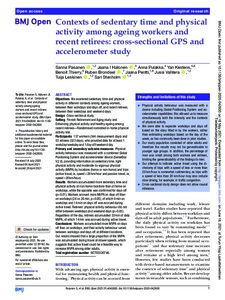Contexts of sedentary time and physical activity among ageing workers and recent retirees: cross-sectional GPS and accelerometer study
Halonen Jaana I.; Stenholm Sari; Pulakka Anna; Kestens Yan; Thierry Benoit; Leskinen Tuija; Pasanen Sanna; Brondeel Ruben; Pentti Jaana; Vahtera Jussi
https://urn.fi/URN:NBN:fi-fe2021100750313
Tiivistelmä
Objectives: We examined sedentary time and physical activity in different contexts among ageing workers, between their workdays and days off, and recent retirees, between their weekdays and weekend days.
Design: Cross-sectional study.
Setting: Finnish Retirement and Aging study and Enhancing physical activity and healthy ageing among recent retirees—Randomised controlled in-home physical activity trial.
Participants: 137 workers (544 measurement days) and 53 retirees (323 days), who provided data for at least 1 workday/weekday and 1 day off/weekend day.
Primary and secondary outcome measures: Physical activity behaviour was measured with a combined Global Positioning System and accelerometer device (SenseDoc V.2.0), providing information on sedentary time, light physical activity and moderate-to-vigorous physical activity (MVPA) by locations (home or non-home) and trips (active travel, ie, speed <20 km/hour and passive travel, ie, speed ≥20 km/hour).
Results: Workers accumulated more sedentary time and physical activity at non-home locations than at home on workdays, while the opposite was confirmed for days off (p<0.01). Workers accrued more MVPA on days off than on workdays (34 vs 28 min, p<0.05), of which 9 min on workdays and 14 min on days off was accrued during active travel. Retirees’ physical activity behaviour did not differ between weekdays and weekend days (p>0.05). Regardless of the day, retirees accumulated 33 min of daily MVPA, of which 14 min was accrued during active travel.
Conclusions: Workers accumulated more MVPA on days off than on workdays, and their activity behaviour varied between workdays and days off at different locations. Our results showed that a large proportion of the MVPA was accumulated during travel at slower speeds, which suggests that active travel could be a feasible way to increase MVPA among older adults.
Kokoelmat
- Rinnakkaistallenteet [19207]
